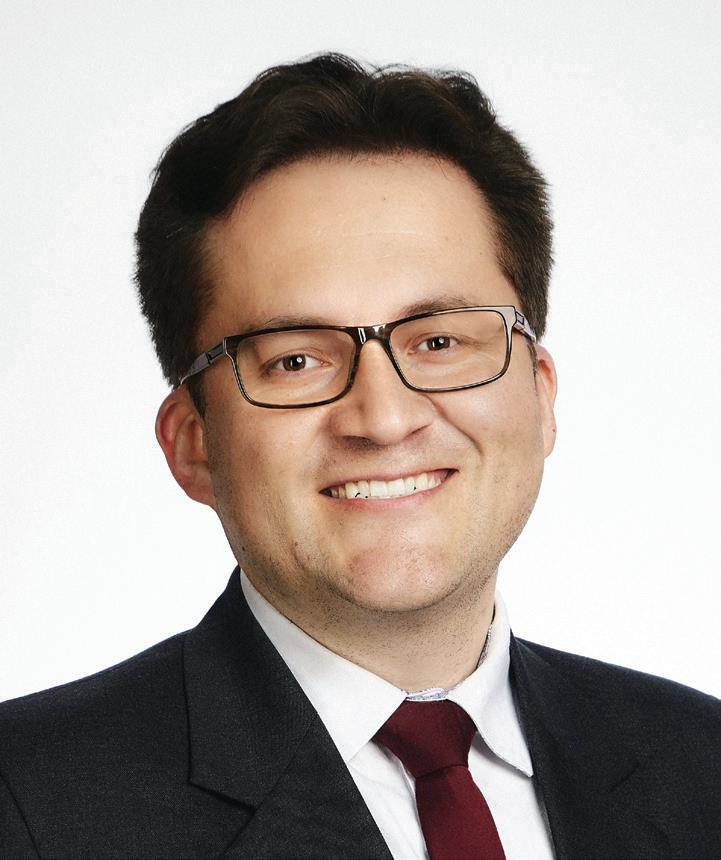
3 minute read
Q&A with Karlo J. Lizarraga, MD, MS
Karlo J. Lizarraga, MD, MS, is an associate professor of Neurology and founding director of the Motor Physiology and Neuromodulation Program. He also has appointments in Neuroscience and Neurosurgery. He completed his MD at the Universidad Nacional de San Agustin and a Master of Science in Clinical Research at the Medical University of South Carolina. After completing his residency in neurology at the University of Miami, he completed fellowships in clinical neurophysiology at the University of Miami and in movement disorders at the University of Toronto. Lizarraga is board-certified in neurology and clinical neurophysiology by the American Board of Psychiatry and Neurology.
Please summarize your research.
The most effective treatments for the motor symptoms of Parkinson’s disease are the dopaminergic drug levodopa and deep brain stimulation (DBS). In addition to their motor benefits, these treatments affect cognition and gait in ways that we do not fully understand. Treatment effects on cognition and gait could contribute to disabling symptoms such as freezing of gait and falls. My research uses high-density EEG techniques to advance the understanding of the effects of levodopa and DBS on cognition and gait, with the goal to personalize treatments and improve outcomes for the growing number of people living with Parkinson’s disease.
How did you become interested in your field?
I was privileged to witness how people affected by movement disorders could go from using a wheelchair to being able to walk, run, and even dance after DBS. This exposure solidified my interest to pursue an academic career in neurology. I went on to complete residency in neurology and fellowships in clinical neurophysiology and movement disorders, focusing on motor physiology and DBS. As a resident, I helped conduct a study that suggested that bilateral and right subthalamic DBS have similar effects on gait in people with Parkinson’s disease. As a fellow in movement disorders, I designed and conducted a study that suggested that levodopa combined with left subthalamic DBS could be harmful for gait but not for cognition in this population.
What brought you to the University of Rochester?
Dr. Robert Griggs, who is an icon in neurology, approached me while I was presenting a poster. I was starstruck. Besides his multiple personal accomplishments, I was really impressed by the NIH-funded training program in Experimental Neurotherapeutics he had built at the University of Rochester School of Medicine and Dentistry. I was attracted to the academic culture, which combines research, education, and patient care and includes several international collaborations.
Who are you collaborating with, and why?
I am collaborating with Ed Freedman, John Foxe, and the team in the Cognitive Neurophysiology Laboratory at the University of Rochester. This laboratory conducts basic science and translational experiments using high-density EEG techniques. Our cross-disciplinary collaboration aims to develop a non-invasive biomarker of the effects of levodopa and DBS on cognition and gait in people with Parkinson’s disease. The first participant in our study displayed a unique EEG pattern associated with notable gait improvement after DBS. We have obtained preliminary data thanks to funding from the Schmitt Program in Integrative Neuroscience (SPIN) Pilot Project Program through the Del Monte Institute for Neuroscience. We are currently applying for extramural funding.
What is your favorite piece of advice?
My favorite advice comes from “The Book of the Five Rings” by Miyamoto Musashi: “No matter how hard you labor, if your heart is not aligned, your course, no matter how seemingly right, won’t be the true one. Without aiming for a genuine path, even a slight mental detour can cause significant deviation. Reflect on this.”



